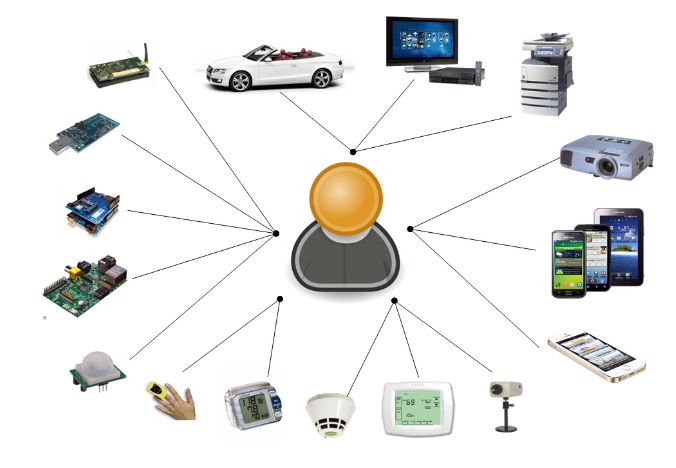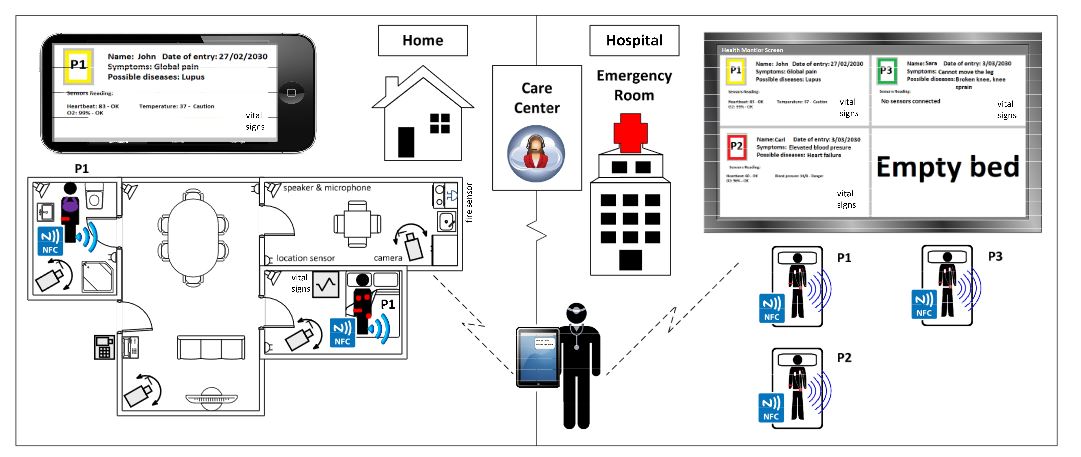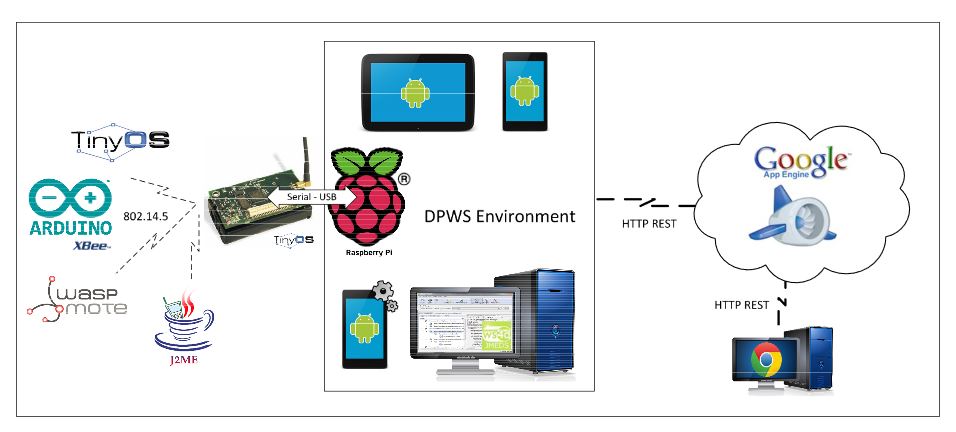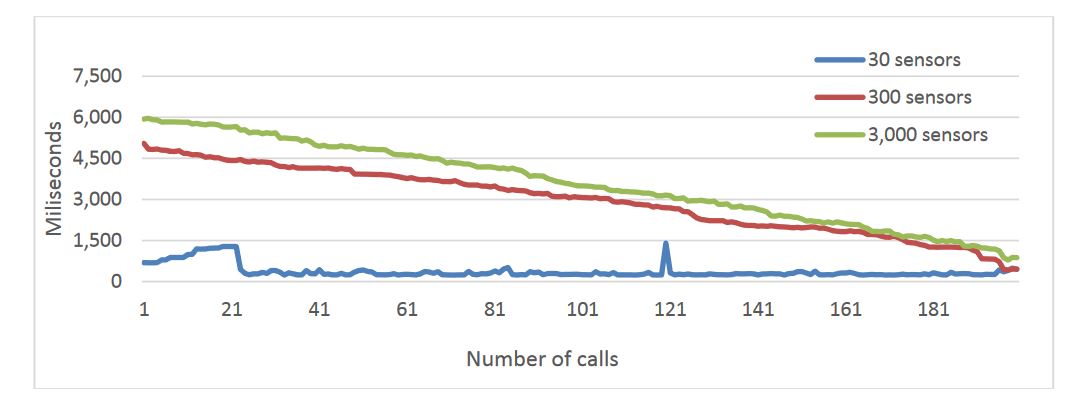ABSTRACT
A common feature of ambient intelligence is that many objects are inter-connected and act in unison, which is also a challenge in the Internet of Things. There has been a shift in research towards integrating both concepts, considering the Internet of Things as representing the future of computing and communications. However, the efficient combination and management of heterogeneous things or devices in the ambient intelligence domain is still a tedious task, and it presents crucial challenges.
Therefore, to appropriately manage the inter-connection of diverse devices in these systems requires: (1) specifying and efficiently implementing the devices (e.g., as services); (2) handling and verifying their heterogeneity and composition; and (3) standardizing and managing their data, so as to tackle large numbers of systems together, avoiding standalone applications on local servers. To overcome these challenges, this paper proposes a platform to manage the integration and behavior-aware orchestration of heterogeneous devices as services, stored and accessed via the cloud, with the following contributions: (i) we describe a lightweight model to specify the behavior of devices, to determine the order of the sequence of exchanged messages during the composition of devices;
(ii) we define a common architecture using a service-oriented standard environment, to integrate heterogeneous devices by means of their interfaces, via a gateway, and to orchestrate them according to their behavior; (iii) we design a framework based on cloud computing technology, connecting the gateway in charge of acquiring the data from the devices with a cloud platform, to remotely access and monitor the data at run-time and react to emergency situations; and (iv) we implement and generate a novel cloud-based IoT platform of behavior-aware devices as services for ambient intelligence systems, validating the whole approach in real scenarios related to a specific ambient assisted living application.
OVERVIEW OF THE APPROACH

Figure 1. A heterogeneous system made up of sensors and devices
An embedded WSN in the healthcare domain consists of heterogeneous components and is used to monitor temperature, humidity, pressure, oxygen, carbon dioxide, heart rate, breathing rate, etc. Sensors and actuators-sensors are used to observe changing situations in the environment. Smart sensors or devices capable of sensing various dimensions in a smart environment are combined to develop a smart hospital, a smart home or any other environment to improve human life. In addition, a heterogeneous system, like an AAL system, may integrate diverse sensors or devices produced to different specifications, as shown in Figure 1. Therefore, it is necessary to design a common architecture to tackle the integration and communication problems, which could be addressed by considering a service-oriented device architecture (SODA).

Figure 2. Emergency monitoring system: remote ( home) and local monitoring (hospital)
In our EMS system, two scenarios can be distinguished. First, a common scenario is when a new patient arrives at the hospital (right-hand side of Figure 2). Using the patient registration system (included in the data repository), the receptionist checks whet her the patient is already registered in the system, in order to assign him/her a unique identifier by using a Near Field Communication (NFC) wristband. The patient is then transferred to the emergency room, and with the bracelet on, depending on the patient’s urgent symptoms, a specialist decides which kind of sensors or devices he/she needs to be connected to. The emergency room is prepared with a gateway or an appropriate device to group all of the sensors, connected to the Internet or the hospital’s intranet.
CLOUD-BASED IOT PLATFORM FOR THE INTEGRATION OF DEVICES

Figure 8. Specific orchestration (with violations) of the device composition for our EMS system
This model is represented as a graph whose nodes represent single (only one action) or complex (more than one action executed at the same invocation) invocations (to actions of the devices) and whose edges represent a precedence relationship among these invocations (an edge from A to B states that Invocation B can be performed only after performing Invocation A). According to the example, different sequences of invocations can be executed in our scenario. Figure 8 presents a possible orchestration defined by the user (in our case, the orchestration could be defined by the healthcare professionals), where nodes represent the actions of each service hosted in the devices.

Figure 11. Technologies used for DEEP
Web-based platform access: this third component uses the external API published by the cloud platform to develop applications as a web interface for the management of personal data or remote monitoring of patients and even mobile clients to perform any operation available in the API (e.g., retrieving the information of a specific patient). This section provides some details of the implementation of the DEEP platform, examining a prototype that has been developed (http://com-gisum-deep.appspot.com/). Figure 11 shows the technologies used for the DEEP platform.
EVALUATION OF THE PLATFORM

Figure 13. The time to perform two usability tests according to the user experience
In Figure 13 is shown the time to perform each usability test according to the user experience. We observe that in all of the cases, the user (independent of her/his computer skills) learns to interact with the platform with a single try, decreasing the time for the second execution by 30% overall.

Figure 14. Platform average response with a single gateway
CONCLUSIONS
In this paper, we have presented a platform to manage the integration and behavior-aware orchestration of devices as services stored and accessed via the cloud in AAL applications. We have described our proposal of modeling the heterogeneous devices as services by using the DPWS standard (which has already been extended with the behavior specification of devices, with the purpose of determining the order of the sequence of exchanged messages during their composition). To solve the variability of the devices, we used a service-oriented environment and a DPWS-compliant gateway used to orchestrate the devices according their behavior.
We have detailed the design and implementation of our cloud-based IoT platform for remotely accessing and monitoring the data at run-time, reacting to emergency situations, which is such a crucial issue in AmI systems. We have validated the whole approach in real scenarios related to a specific AAL application, an emergency monitoring system, to help medical professionals with the seamless health monitoring of a large number of patients and data at run-time, by means of sensors and devices connected to the patient, so as to detect and prevent any emergency situation, both in the hospital (local) and at home (remote).
We have demonstrated that the cloud solution eases the management of these systems, allowing simplified user access and effectively handling demand elasticity. Currently, we are working on developing the historical triggers and the patient schedule. We are also refining the connection of the system with th e appropriate actuators, in order to automatize as many parts of our solution as possible. As regards future work, we plan to evaluate and validate the whole solution from the very beginning of abstracting the devices as services through to the analysis of the monitored information by using the cloud.
Authors: Javier Cubo | Adrian Nieto | Ernesto Pimentel
>> 200+ IoT Led Projects for Final Year Students
>> IoT Projects in Medical Field for Engineering Students